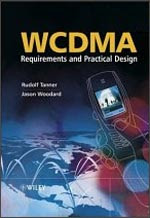
Wideband TDD: WCDMA for the Unpaired Spectrum
Wiley May 28, 2004 ISBN: 0470861045 286 pages PDF 5 Mb
3rd generation radio systems will be increasingly developed, deployed and operated in the years to come. TDD is one of two main approaches to implementing these 3G systems, so that there will be an increasing need for the engineering community to learn quickly and comprehensively about the TDD technology. As 3G systems become popular, the topics will no doubt be introduced to academic curricula and will also provide a basis for future research.
This book provides comprehensive coverage of TDD. It is essentially a Radio Access Network technology and the book embraces the structure of the radio interface as well as the user equipment and network equipment. In addition, Wideband TDD also covers the connection of the TDD Radio Access Network to the 3G Core Network and public switched networks (PSTN) as well as public and private packet networks (Internet and Intranet). Services, applications and performance are also addressed. Finally, TDD is compared with other radio access technologies, namely FDD, TD-SCDMA and WLAN. TD-SCDMA is the Narrowband version of TDD in 3G, and WLAN standards address wireless computer communications.
Although there are a number of books published on 3G and UMTS, most of the focus of these books has been on FDD component of 3G.Wideband TDD:
* Describes all aspects of TDD in a single comprehensive manner
* Addresses TDD technology, TDD systems and the TDD market place
* Discusses deployment scenarios and Radio Resource Management for TDD
* Provides a comparison of TDD with other radio access technologies, namely FDD, TD-SCDMA and wireless LANs
This will prove an essential addition to the bookshelf of professional communication and software engineers, development engineers, technical marketing professionals, researchers in industry, wireless equipment vendors such as Siemens, Nokia and InterDigital, operators and service providers.It will also provide a comprehensive overview of TDD for postgraduates who are taking advanced courses in Mobile Wireless communications.
From the Back Cover
The 3rd generation mobile wireless technology standardized by 3GPP has two main components, namely FDD (Frequency Division Duplex) and TDD (Time Division Duplex). While both of these employ WCDMA, the former uses a pair of frequency bands and the latter uses a single unpaired frequency band. Within TDD, two versions have been standardized, namely the Wideband TDD (also referred to as High Chip Rate TDD) and Narrowband TDD (also referred to as Low Chip Rate TDD or TD-SCDMA). Wideband TDD: WCDMA for the Unpaired Spectrum focuses on the Wideband TDD version. It brings together in one place the vast TDD related information, scattered amongst the numerous 3GPP Technical Specifications and Reports. The book also presents significant amount of valuable information related to Receiver, Radio Resource Management and Network implementation technologies (not found in Standards).
The book offers:
* A comprehensive overview of WTDD Technology for the engineering, research and student communities.
* A background to the fundamentals of WCDMA & Time Division Duplexing.
* Detailed account of the WTDD Radio Interface, including Protocols and Procedures
* Presentation of Receiver Signal Processing and Radio Resource Management techniques
* Exposition of various Deployment Scenarios and Techniques
* A comparison of TDD and other radio access technologies, namely TD-SCDMA and WLAN. Written in an accessible manner this book will be highly popular with engineering and technical marketing professionals from network operators, mobile equipment and component manufacturers, as well as industry regulators and academia. Postgraduates who are taking advanced courses in Mobile Wireless communications will also find Wideband TDD: WCDMA for the Unpaired Spectrum invaluable.






